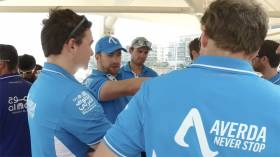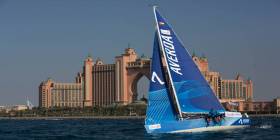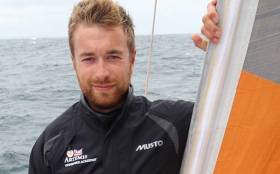Displaying items by tag: Andrew Baker
Strangford Lough's Andrew 'Hammy' Baker Appointed RYA Northern Ireland High Performance Manager
Accomplished sailor Andrew Baker has been appointed as the new RYA Northern Ireland Performance Manager, taking up the post this week.
Recruitment for the role started in February but was delayed until lockdown measures eased and continued funding form Sport Northern Ireland was confirmed.
Baker takes over from Ballyholme-based 49er sailor Matt McGovern who previously held the role.
Popularly known as 'Hammy' Andrew started competitive sailing at the age of nine, racing Toppers in his native Northern Ireland. By the age of 13, he was selected to be part of the RYA Northern Ireland Youth Squad in Toppers, and two years later in the Laser Youth Squad. After winning the Northern Ireland Youth National Championship, he represented Ireland in the Laser Europeans and World Championship. In 2014, Andrew was selected as part of the British Keelboat Academy and won the IRC National Championship.
His big break came when he got accepted into the Artemis Offshore Academy to be part of the 2015 squad. After training in Lorient, he took part in his first Solitaire – Bompard Le Figaro, finishing the race in 32nd place. Since then he has worked as a professional sailor but has also returned to work and assist as a Senior Instructor at his home club of Quoile YC in Strangford Lough.
Welcoming Andrew to the RYA Northern Ireland team, Chief Operating Officer Richard Honeyford said: "At RYA Northern Ireland, we are delighted to welcome Andrew on board as the new Performance Manager at a critical time for performance sport and our local athletes. With the Olympics delayed until 2021, Andrew will be looking to ensure our High-Performance athletes get the best possible support as well as looking to ensure the pathway and club development plans are prioritised."
Commenting on his new post, Andrew said: "Since our first family holidays on my parents' boat right up to sailing competitively at a professional level, I have always felt very fortunate to be involved in this sport and I realise it would not be possible if not for the work of our clubs, volunteers and the work carried out by the RYANI. Having gone from club racing and through the squad systems myself I know how important this stage of coaching and nurturing is to a future athlete. I hope to carry on the great work carried out by my predecessors and give something back to the sport I love through growing the depth of sailing here in Northern Ireland. To me sailing is a sport for life and I hope it can be for others too."
Northern Ireland Sailors Lead in New Sailing Speed Record
Mikey Ferguson from the Royal Ulster YC on Belfast Lough and Andrew Baker from the Quoile YC on Strangford Lough have played a key role in establishing a new mono-hull record for the 620-mile course from Land’s End in southwest England to John O’Groat’s in northeast Scotland writes W M Nixon.
At first glance, the previous record - established by Phil Sharp with an Open 40 in 2015 - looked to be eminently beatable with a time of 3 days 11 hours and 52 minutes to provide an average speed of “only” 7.39. After all, the Artemis crew of Mikey Ferguson, Andrew Baker, Lizzy Foreman, and Jack Triggger (the latter recruited from the Team Concise), were racing their much larger IMOCA 60, which established a 5 day 14 hours record for the 2,000-mile Round Britain and Ireland circuit in 2014.
But the shortest course from Land’s End to John O’Groat’s takes you through all sorts of tide-riven channels – St George’s Channel and the North Channel to name only two – which can not only build up boat-breaking seas when strong winds are against the stream, but as the coast is sometimes close – sometimes very close - and frequently steep-to as well, it can play all sort of games with wind strength and direction.
Taking an Open 60 through it all at maximum speed is a bit like riding a tiger through a maze. Everything needs to be working properly, but after they’d starting zapping north from Land’s End at 1500hrs UTC last Friday (Sept. 22nd) with everything looking good for favourable and vigorous winds thanks to a deep low out beyond Ireland giving a strong southerly airstream, the wind instruments started to go on the blink.
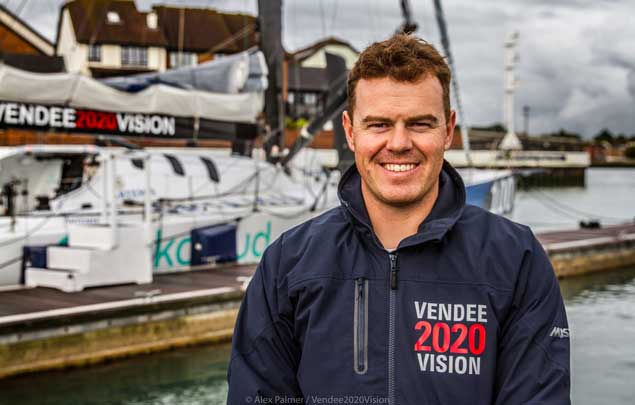 “We had to throttle back at night after the wind instruments had failed, as a crash gybe in those conditions would have been disastrous”
“We had to throttle back at night after the wind instruments had failed, as a crash gybe in those conditions would have been disastrous”
When they failed completely, Mikey Ferguson made the decision to sail during the long hours of darkness at one notch below maximum power in order to cut a bit of slack for helmsmen having to steer by feel through the long Equinoctial night – “a crash gybe would have been total disaster”.
Thus although average speed was well above the required minimum, off Wicklow Head early on Saturday morning they were making a modest 14 knots, but within two or three hours were going better past Dundalk Bay at 16.8 knot. However, sail damage and problems with the mainsail carriage made a two hour stop in flat seas a dream solution, and Mikey’s home waters of Belfast Lough came up trumps. He even brought the boat into the lough through the narrow and rocky Donaghaee Sound inside Copeland Island to save time.
A couple of hours of hectic activity off Bangor put things right. They then exited the lough in the evening past Black head at 17.3 knots - probably the best through-the-water speed achieved, for although they were showing 18.8 knots approaching Fair head, there was tide involved. They went outside Rathlin and on into a miserable night - “lousy visibility and always that fear of gybing” – to make their way out past Islay and into the Sea of the Hebrides inside the Western Isles.
By this time the real power was going out of the wind, and on Sunday evening as night drew on and they sailed past Cape Wrath, the unthinksable happened. It became totally windless. Not calm by any means, but not a breath of a breeze. They struggled across Scotland’s north coast in any scraps of wind they could find, and slowly the Orkneys came up on the port hand this (Monday) morning, and the Scottish mainland crawled by to starboard.
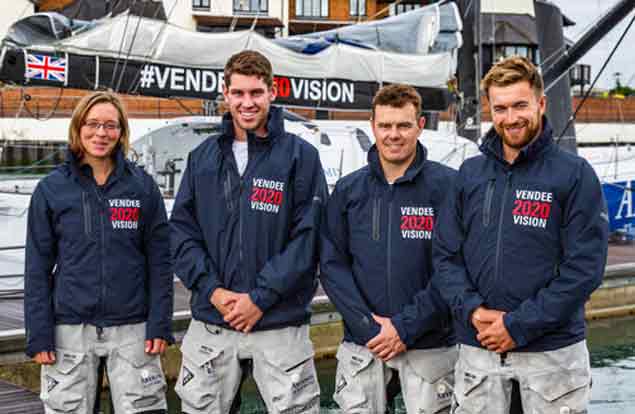 Artemis crew of Lizzy Ferguson, Jack Trigger, Miker Foreman, and Andrew Baker
Artemis crew of Lizzy Ferguson, Jack Trigger, Miker Foreman, and Andrew Baker
Ideally, to finish such a record passage with an appropriate flourish, you sweep through the Pentland Firth close past John O’Groat’s on the mainland side and Duncansby Head beyond it, with the Orkneys well away on the port hand. But in struggling to cross the virtual finish line running due north from John O’Groat’s, the Artemis crew actually found themselves well over on the Orkney side early this morning as they made it across to bring the record down to 2 days 14 hours 6 minutes and 44 seconds. They’ve taken a clean 21 hours and 44 minutes off the previous record. But as Robin Knox-Johnston said of his new Round Ireland Record in May 1986: “It’s still eminently beatable”.
Northern Ireland Sailors Mikey Ferguson & Andrew Baker Standby for Length of Britain Challenge
Four young offshore sailors, including two from Northern Ireland, Mikey Ferguson and Andrew Baker, are on standby for an assault on the Length of Britain Challenge, from Land’s End to John O’Groats. The current record held by British sailor Phil Sharp stands at 3 days, 11 hours, 52 minutes, 15 seconds at an average speed of 7.39 knots.
The team who will be racing onboard the Open 60 Artemis Ocean Racing are currently waiting for an optimum weather window for this iconic 620 nm British course. The team sails along the English & Welsh coastline westabout up to Pentland Firth on the north coast of Scotland, the final marker before the finish line off John O’Groats.
Launched in 2016, Vendee2020Vision is an initiative to nurture Britain’s Offshore sailing talent along the path to success in yacht racing’s most challenging event - the Vendée Globe, the quadrennial singlehanded non-stop round the world race. This record attempt will see the current candidates test their skills in some of the coldest and most challenging conditions off Britain’s coastline.
No stranger to setting records, in 2014 Artemis Ocean Racing took the World Record for Monohulls 60 feet and less for Round Britain and Ireland in a time of 5 days, 14 hours, 00 minutes and 54 seconds.
The crew features two of the Vendee2020Vision’s current candidates, Lizzy Foreman and Andrew Baker. They will be joined by Artemis Skipper and Boat Captain Mikey Ferguson and a new addition to the team for this record sail is Jack Trigger. Jack is one of Britain’s up and coming offshore sailing talents, and also the youngest crew member onboard. He has sailed across a variety of classes most notably he has been part of the record-breaking crew onboard the MOD70 Concise.
Alongside the assault on this British record, the team will also use this opportunity to test several pieces of wearable technology to provide vital data to assist the team in improving overall performance and health at sea. From monitoring sleep cycles and baseline vitals during an offshore race, the team will also work with Jack Trigger, a Type 1 diabetic, to see how wearable tech can assist in the management of his condition offshore.
In the final instalment of his three-part series, Vendee 2020 Vision solo sailor Andrew Baker emphasises an often neglected but crucial element in training for any performance sailing activity: recovery.
We all can appreciate the importance of training hard. Most of us also understand a healthy diet is beneficial, even down to the micronutrients within the food – the balance of protein, carbohydrates, etc.
However, after all the hours grafting in the gym, training, eating right – all the ‘hard parts’ – very few people take the time, or maybe lack the knowledge, for proper recovery.
You wouldn’t buy a car and simply run it into the ground. You hand it over to a mechanic to maintain, not to mention changing the tyres, oil, bulbs and more. Your body is no different: the more you use your body training, the more you must maintain it.
Some simple practices are to properly warm up before exercise. Do not lift more than you can handle with correct technique; the girls aren’t impressed. Cool down effectively and stretch/move the worked muscles.
From here there is a plethora of different ideas on optimal recovery. Ice baths, heat, compression and acupuncture are all widely publicised and preached. I believe each has its uses, so feel free to experiment with what works for you.
After events or a particularly hard training session, I always use massage to aid recovery. It is also a great way of monitoring your body. If you feel constantly sore or tight in certain places, it can show over training or in a weakness somewhere else that needs attention.
I will have a deep-tissue sports massage but on top of this, I use a foam roller and a lacrosse ball to work on knots, help my posture and relieve any aches before they develop further.
Flexibility
Flexibility can be improved in two ways. Working on one’s stability and ability to perform the correct technique will help prevent you getting tight and losing flexibility, a common issue due to the nature of the movements found in sailing.
I also perform stretches mainly for improving posture, as in offshore racing you sit in static positions for long periods of a time and it’s easy to end up hunched over with rounded shoulders.
On-The-Road Training
Getting exercise in while on the road can be a little harder but not impossible. It requires a bit of improvising and imagination. Tree branches or even kids’ play parks can provide the perfect backup gym - but don’t push the six-year-olds off the monkey bars just so you can do you pull-ups!
Equipment
I always have some simple equipment with me:
- Gymnastic rings are a fantastic piece of equipment and make it possible to perform almost any exercise utilising only your body weight. They are also great for working the smaller stabiliser muscles and moving your body.
- Skipping can be a great way to get in some cardio or HIIT training without always having to go for a run. A skipping rope is small and easy to keep in the bottom of your bag.
Where To Take It From Here?
There are never any excuses not to get fitness training done – we can all do more, myself included. Consistency is key. And the secret to that is to avoid getting bored in the same old workout – have fun and mix it up!
Living an active lifestyle in your spare time can be a great first step towards your fitness goals. A good run along the beach with some body-weight movements while the sun is setting as you wait on the BBQ to light up is hard to beat after a long day on the water. Make it a part of your everyday life and you’ll soon see results in your performance on the waves.
Previously in this series, Andrew Baker wrote about his personal training regimen and making the most of your own gym sessions.
How To Get Fit For Solo Sailing: Hitting The Gym
In the second of a three-part series, Vendee 2020 Vision solo sailor Andrew Baker breaks down his workout regimen - with tips for how you can make the most out of your own gym sessions.
Weight Training
Size & Strength: Trying to increase size and strength has to be my favourite form of fitness. I am not saying it’s the most important, but this form of training is what I enjoy doing the most. When really focusing on this part, I fall somewhere between a body builder and an Olympic weightlifter with my regime. I always start with the heavier, more complex exercises first, then work down, and eventually may hit individual muscles.
Example Session For Pulling Muscle Groups
| Exercise | Weight (%max) | Reps | Sets |
|---|---|---|---|
| Clean | 90 | 4 | 5 |
| Deadlift | 90 | 5 | 5 |
| Chins | Bodyweight | 8 - Failure | 4 |
| Bent over row | 70 | 8 | 4 |
| Barbell curls | 70 | 8 | 3 |
Circuit: Circuit training is very good at making the body work as one and helping remove any imbalance. It also starts to lean towards cardiovascular training, but utilising weights gives a good base to work from. I have used CrossFit classes to make it bit more fun, but generally the circuits consist of weightlifting with less rest and lighter weights – sometimes just body weight is plenty.
Cardiovascular
Endurance: The best way to gain endurance for a specific sport is to take part in that sport as much and for as long as possible. It is hard to train to last longer when your workouts tend never to exceed an hour.
For myself, I jump on a spin bike or a treadmill and get my heart rate to 70% max. I will then sit at this level for 90 minutes. Generally, this will be the intensity where you have an increased breathing rate and can feel your heart pounding but can just about still talk as you perform the exercise.
Boredom can be the common issue with these sessions, so download your favourite TV series onto your phone or tablet and catch up while you sweat.
HIIT: High-intensity interval training, or HIIT, involves alternating between very intense bouts of exercise and low-intensity exercise. For example, sprinting for 30 seconds, then walking for 30 seconds. One HIIT workout I like to do is rowing and burpees, where the main goals are to burn fat and build explosive power. The key to this form of training is to give maximum effort – and I really do mean max effort!
HIIT is also great when short on time. A typical workout will take under half an hour. I use it a lot in the evenings after a busy day and save the longer runs or cycling for the weekends or days off.
Stability & Stretching
Boats are an unsteady platform at the best of times, on which we must move around and perform careful movements of balance. Try doing a deadlift in a gym to replicate lifting a folded sail. Now imagine the floor is on a 40-degree slant and bouncing up and down; building up strong joints around hips and knees is important. To do this I perform movements requiring balance and co-ordination, such as single-leg squats, overhead squats, step-ups and hip-raises.
Core
With many sports, core strength is the key component that the body relies on for every movement. In sailing, this couldn’t be more prominent. As said before, stability is crucial when moving on board. But more than this, a solid core also keeps good posture. I work my core in two main ways: static work and dynamic.
Static consists of isometric exercises – basically holding positions, such as a simple plank. I mix it up a bit using my arms on a Swiss ball to increase the difficulty and make the stabiliser muscles around the core fire up and work harder.
Dynamic work involves crunches and back raises but also a lot of twisting motions such as the woodchopper or medicine ball throw.
Andrew Baker’s sailing fitness series began yesterday with his own routine for optimum performance, and concludes tomorrow with an often neglected but crucial element in training for any performance sailing activity: recovery.
How To Get Sailing Fit: Top Tips From An Offshore Pro
In the first instalment of a three-part series, Vendée 2020 Vision solo sailor Andrew Baker explains the importance of sailing fitness - and lays out his own routine for attaining and maintaining optimum performance on deck
Fitness is not always the first thing associated with sailing – and maybe even less so in yachts when compared to the lighter Olympic classes. However, with sailing becoming increasing competitive, fitness is always an important factor. With such small margins separating the top guys from the rest of us, simply being fitter can make the difference when tiredness and fatigue starts to creep in.
Fitness tests are also becoming commonplace at many team selections, so better fitness can be something to set you apart from the influx of sailors who all want a spot on board the race teams of tomorrow.
My own reasons for fitness are aimed towards solo sailing, but with a background in Olympic classes and aspiring to a future in the bigger, more powerful yachts such as those found in the Volvo Ocean Race or the high-speed multihulls, I will try and cover all the bases.
Whatever the situation, however, cardiovascular fitness is a must. Fast boats can have you running around performing multiple fast movements, with your heart rate pushing its max during manoeuvres. The hauling of sails and stacking on board, the ever-increasing sheet loads and constant grinding – all of that lends itself to the bigger, stronger lads.
The Figaro hasn’t required the same efforts, but fitness is still key. After completing my second Figaro and now sailing on the much larger, faster IMOCA 60 yacht, I must continue to build myself for the future.
What’s My Routine?
Throughout the season my routine changes, mainly due to changing goals but also due to time constraints and available equipment.
Generally, in the off-season outside of events, I focus on getting stronger, rebuilding any lost muscle from the past season and trying to gain more. This gives a solid foundation to work on as we build up to the races, as it’s easier to boost up your fitness in a shorter time than it is to slave away in the gym to gain muscle. I also have more access to weights and equipment in the winter months, before the travelling and events make it harder to find local gyms.
Ahead of the racing season, it’s all about cardiovascular fitness and flexibility, while during the season it’s a lot more about recovery and maintaining fitness.
I should mention I am fortunate enough to be an affiliate with Chris Szedlak, the lead strength and conditioning coach at the University of Southampton. I have regular meetings and testing with Chris he monitors my progress – or sometimes lack of – so we can alter my current regimen as required.
Outside of this training, I work with physios and other trainers to address any injuries and ensure I’m fit to train – most notably Row Quinn of Row Quinn Strength and Health. Row is a lover of life and movement. I receive constant new ideas from him and ways to make my training more enjoyable. When I am home a catch-up with this guy normally involves a deep tissue massage and some playing around with a new move or some gymnastics.
Andrew Baker continues his solo sailing fitness series tomorrow with a breakdown of his training regimen - and tips for how you can make the most of your own gym sessions.
Baker & Espey Battling Hard in Sailing Tour of Arabia
Northern Ireland sailors Andrew Baker and James Espey are fighting hard in the Sailing Arabia Tour onboard Team Averda but it is a veteran crew that saw off spirited attacks from rivals Team Al Mouj Muscat (OMA) and Team Zain (KUW) to seal the top spot in the 153-nautical mile sprint from Khasab on Oman's Musandam Peninsula to Abu Dhabi.
The triumph, their second in three legs, is all the more impressive given the hurdles EFG Bank Monaco faced on the leg – at one point their Farr 30 racing yacht became entangled in a fishing net, causing them to lose the lead to Team Al Mouj Muscat, but they were able to recover and overhaul their rivals in the early hours of this morning.
It puts the three-time winners of EFG Sailing Arabia – The Tour, led by Frenchman Thierry Douillard and including former match racing world champion Mathieu Richard, 4 points clear at the top of the overall standings with two offshore legs and two in-port race series remaining.
“It was a great leg – we had a good start sailing around the beautiful Musandam coastline and we were fast,” Douillard said.
“We sailed solidly and were leading at the first gate just as night came. We then had some issues with fishing nets... we were caught for quite a while by a big one and slipped back to fourth. We fought back very hard because we knew we would be reaching at the end of the leg with little opportunity to overtake. I'm very happy with the job the boys did.”
Team Al Mouj Muscat notched up another second-place finish, coming in just eight minutes adrift of EFG Bank Monaco's winning time of one day, two hours and 55 minutes.
But the biggest celebrations came from Team Zain, who scored their first podium result after having to settle for fourth in the two opening legs.
“We're absolutely delighted with the result,” said Team Zain crew manager Mike Miller.
“At one point we were actually leading but as we came into the home strait the professional crews took us to the cleaners. Thankfully we were able to hang on this morning and score our first podium of this year's race. It was hard work but we really deserve this result.”
Behind the top three an intense battle raged for fourth place between Leg 1 winners Team Renaissance (OMA), race newcomers Adelasia di Torres (ITA) and Bienne Voile (SUI).
After more than 26 hours at sea the three crews finished within 90 seconds of one another, Team Renaissance coming home just ahead of Bienne Voile and Adelasia di Torres.
Team Averda (GBR) took seventh place ahead of all-female crew DB Schenker (GER) in eighth.
The teams now have a day in the UAE capital city to recover before racing resumes on Wednesday morning with Leg 4, the penultimate stage of the 763nm Arabian classic that will see the fleet race to Doha, Qatar, a 160nm stage with another night – if not two – at sea.
Once in Doha the teams will contest the second in-port race series of EFG Sailing Arabia – The Tour, a vital opportunity to score points before the final offshore leg to Dubai which begins on February 26 and a last in port race.
Results of Leg 3:
EFG Bank Monaco (MON/Thierry Douillard) – 1.5 points
Team Al Mouj Muscat (OMA/Christian Ponthieu) – 3 points
Team Zain (KUW/Cedric Pouligny) – 4.5 points
Team Renaissance (OMA/Fahad Al Hasni) – 6 points
Bienne Voile (SUI/Lorenz Mueller) – 7.5 points
Adelasia di Torres (ITA/Renato Azara) – 9 points
Team Averda (GBR/Andrew Baker) – 10.5 points
DB Schenker (GER/Annemeike Bes) – 12 points
Overall results:
EFG Bank Monaco (MON/Thierry Douillard) – 5 points
Team Al Mouj Muscat (OMA/Christian Ponthieu) – 9 points
Team Renaissance (OMA/Fahad Al Hasni) – 11.5 points
Team Zain (KUW/Cedric Pouligny) – 14.5 points
Adelasia di Torres (ITA/Renato Azara) – 23 points
Bienne Voile (SUI/Lorenz Mueller) – 26.5 points
Team Averda (GBR/Andrew Baker) – 27 points
DB Schenker (GER/Annemeike Bes) – 27.5 points
Andrew Baker & James Espey Race In Sailing Arabia – The Tour
#SailingArabia - Strangford Lough solo sailor Andrew Baker is following his role in Enda O’Coineen’s Vendée Globe campaign with a new job as skipper of the Averda Sailing Team in the EFG Sailing Arabia – The Tour 2017.
‘Hammy’ replaces the injured Marcel Herrera as skipper of the team, and he’s joined by fellow Irish sailor and London 2012 Olympian, James Espey of Ballyholme YC, in the youngest squad to take part in the Gulf region’s only long-distance sailing event — which kicked off yesterday (Wednesday 15 February) and continues for the next two weeks.
The young upstarts will have their work cut out for them in an eight-boat fleet that set sail from Muscat yesterday and boasts top-ranking team sailing talent, from Volvo Ocean Race crew Dee Caffari to Dutch Olympic sailor Annemieke Bes, who skippers her own all-female German team DB Schenker.
The Averda Sailing Team Facebook page has video of action from the Tour’s first leg:
Northern Ireland Sailors Compete in Sailing Arabia Tour
Strangford Lough's Andrew 'Hammy' Baker will skipper Team Averda in February's offshore fixture Sailing Arabia, Here he describes the fortchoming adventure that includes a new crewman, Olympic sailor James Espey from Ballyholme Yacht Club
Coming into the new year and people are looking towards the season ahead. Most are planning their calendar and checking on their boats after the winter but the cold keeps them at bay for now. The thought of sanding down the bottom and polishing topsides can wait another few weeks.
Fortunately, enough I am to be spared the freezing weather and getting back to sailing in the warmer climates of Oman. EFG Sailing Arabia - The Tour kicks off from Muscat on the February 13th. The concept is fairly simple;
• 6 great locations
• 5 legs of offshore sailing
• 3 in port races
The event delivers high-level racing which will attract top amateur and professional sailors from all over the world to one in one of the most beautiful sailing destinations. Farr 30s are the boat of choice, lively and relatively simple mean the racing will be very close and intense, stretching each crew to the full, testing their skill, teamwork and versatility. Most importantly it is strict one design. So the top team will win and there can be no excuses from anyone else.
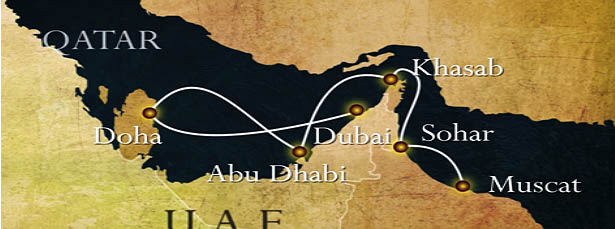 The Sailing Tour Arabia route starts in Muscat
The Sailing Tour Arabia route starts in Muscat
I will be skippering Team Averda. Named after our title sponsor Averda, the largest integrated waste management company who founded in 1964 with their corporate HQ in Dubai, now operate in more than fourteen countries.
Last year we managed a very close third place after having led in the early stages so I am confident we are in a good place in this edition. This year’s crew is made up of top offshore and inshore sailors. From the Bow back we have Liam Gardner, a member of Abu Dhabi Ocean Racing's triumphant shore crew in the 2015 Volvo Ocean Race, Ollie Mellor and Ed Davidson both involved with the MOD70 Team Concise. Navigator or (navi-guesser) Robin Elsey is like myself is a graduate of the Artemis Offshore Academy so I have a lot of experience and confidence working with him from past events. Moving from offshore to inshore racing we have James Espey, who may of us will know has multiple Irish Laser championships under his belt and having represented Ireland in the London 2012 Olympics is keen to get more involved in the world of yacht racing not to mention helping me boost the Irish presence.
Preparation is always key and is all the more relevant in an event such as this with such quick turnaround between legs. Keeping onto of everything and being stress-free could be a huge advantage. With this in mind, we have prepared our meals in advance bringing 170 ‘Wet Meals’ supplemented it with some fresh food when we get out there. Our first port of cal when getting out there is giving the boat a once over. Turning the rig to suit our weight, a swim to check the underside, service winches and blocks etc. We really are planning to leave no stone unturned and intend to leave everything on the race course. If you don’t push hard enough you have no chance of winning, push too hard and you can burn out and the results will suffer. Finding the right rhythm early on will be crucial a lot of which will be dictated by our opposition and the strategies they employ.
Of course, a big part of why we do EFG Sailing Arabia - The Tour, is to experience some amazing places and see some extraordinary sights. The schedule is demanding but there is a real incentive to finish first in each leg because you then get to spend more time in the stopovers. if things go well for us, we could end up Go Karting in Doha, skiing in Dubai or lying on a beach at any of these places. Which is just fine with me
For more information on the 2017 edition of EFG Sailing Arabia – The Tour click here
Strangford Lough solo sailor Andrew ‘Hammy’ Baker has been announced as the newest team member of Enda O'Coineen's campaign to be the first Irish person to compete in the Vendee Globe race, the non stop, unassisted, race around the world, the Everest of sailing challenges.
Hammy is part of the team that will prepare the boat, optimise performance, and work with Skipper O’Coineen ahead of the Vendee Globe Race start in November.
Hammy aspires to be the first Northern Irish sailor to compete in the Vendee Globe. The race takes place every four years and involves a grueling lap of the planet, alone, through the Southern Ocean. Speaking about the announcement Hammy said:
“To be involved in an all Ireland Team is definitely a huge step towards that end goal… This week he sailed into Belfast where he spent his life sailing on O'Coineen's IMOCA 60.
He previously competed in a solo sailing campaign in a 33-foot yacht where many of the top ocean racers learn the ropes.
The boat will be in Dublin on a round Ireland promotional voyage this weekend.


































